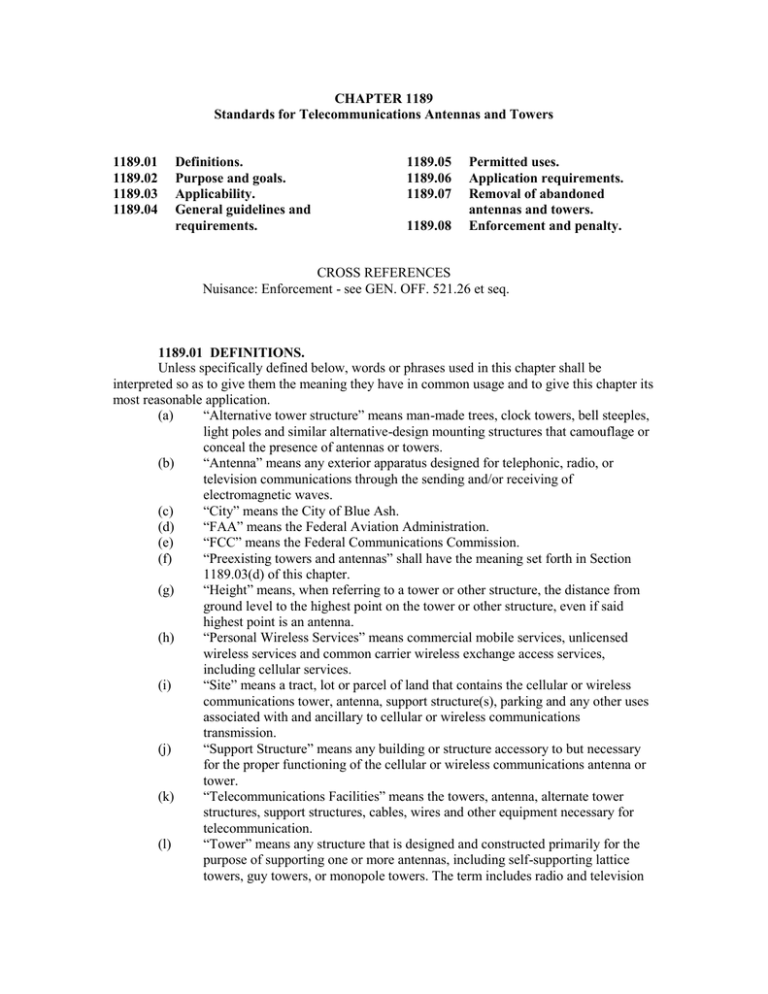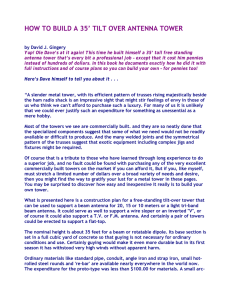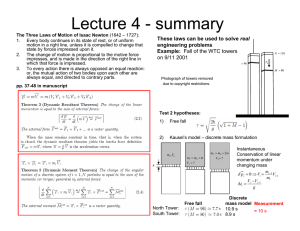Standards for Telecommunications Antennas and Towers
advertisement

CHAPTER 1189 Standards for Telecommunications Antennas and Towers 1189.01 1189.02 1189.03 1189.04 Definitions. Purpose and goals. Applicability. General guidelines and requirements. 1189.05 1189.06 1189.07 1189.08 Permitted uses. Application requirements. Removal of abandoned antennas and towers. Enforcement and penalty. CROSS REFERENCES Nuisance: Enforcement - see GEN. OFF. 521.26 et seq. 1189.01 DEFINITIONS. Unless specifically defined below, words or phrases used in this chapter shall be interpreted so as to give them the meaning they have in common usage and to give this chapter its most reasonable application. (a) “Alternative tower structure” means man-made trees, clock towers, bell steeples, light poles and similar alternative-design mounting structures that camouflage or conceal the presence of antennas or towers. (b) “Antenna” means any exterior apparatus designed for telephonic, radio, or television communications through the sending and/or receiving of electromagnetic waves. (c) “City” means the City of Blue Ash. (d) “FAA” means the Federal Aviation Administration. (e) “FCC” means the Federal Communications Commission. (f) “Preexisting towers and antennas” shall have the meaning set forth in Section 1189.03(d) of this chapter. (g) “Height” means, when referring to a tower or other structure, the distance from ground level to the highest point on the tower or other structure, even if said highest point is an antenna. (h) “Personal Wireless Services” means commercial mobile services, unlicensed wireless services and common carrier wireless exchange access services, including cellular services. (i) “Site” means a tract, lot or parcel of land that contains the cellular or wireless communications tower, antenna, support structure(s), parking and any other uses associated with and ancillary to cellular or wireless communications transmission. (j) “Support Structure” means any building or structure accessory to but necessary for the proper functioning of the cellular or wireless communications antenna or tower. (k) “Telecommunications Facilities” means the towers, antenna, alternate tower structures, support structures, cables, wires and other equipment necessary for telecommunication. (l) “Tower” means any structure that is designed and constructed primarily for the purpose of supporting one or more antennas, including self-supporting lattice towers, guy towers, or monopole towers. The term includes radio and television transmission towers, microwave towers, common-carrier towers, cellular telephone tower, alternative tower structures, and the like. (Ord. 2003-1. Passed 3-13-03.) 1189.02 PURPOSE AND GOALS. The purpose of this chapter is to establish general guidelines for the siting of towers and antennas. The goals of this chapter are to: (a) Encourage the location of towers in non-residential areas and minimize the total number of towers throughout the community; (b) Encourage strongly the joint use of new and existing tower sites; (c) Encourage users of towers and antennas to locate them, to the extent possible, in areas where the adverse impact on the community is minimal; (d) Encourage users of towers and antennas to configure them in a way that minimizes the adverse visual impact of the towers and antennas; and (e) Enhance the ability of the providers of telecommunications services to provide such services to the community quickly, effectively, and efficiently. (f) Protect the public health, safety, and welfare of the City. (Ord. 2003-1. Passed 3-13-03.) 1189.03 APPLICABILITY. (a) District Height Limitations. The requirements set forth in this chapter shall govern the location of towers that exceed, and antennas that are installed at a height in excess of, the height limitations specified for each zoning district. The height limitations applicable to buildings and structures shall not apply to towers and antennas. (b) Public Property. Antennas or towers located on property owned, leased or otherwise controlled by the City shall be exempt from the requirements of this chapter, provided a license or lease authorizing such antenna or tower has been approved by the City. (c) Amateur Radio: Receive-Only Antennas. This chapter shall not govern any tower, or the installation of any antenna, that is under seventy (70) feet in height and is owned and operated by a federally-licensed amateur radio station operator or is used exclusively for receive only antennas. (d) Pre-Existing Towers and Antennas. Any tower or antenna for which a permit has been properly issued prior to the effective date of this chapter shall not be required to meet the requirements of this chapter, other than the requirements of Section 1189.04(d) and (e). Any such towers or antennas shall be referred to in this chapter as “preexisting towers” or preexisting antennas”. (Ord. 2003-1. Passed 3-13-03.) 1189.04 GENERAL GUIDELINES AND REQUIREMENTS. (a) Principal or Accessory Use. Antennas and towers may be considered either principal or accessory uses. A different existing use or an existing structure on the same lot shall not preclude the installation of an antenna or tower on such lot. For purposes of determining whether the installation of tower or antenna complies with district development regulations, including but not limited to setback requirements, lot coverage requirements, and other such requirements, the dimensions of the entire lot shall control, even though the antennas or towers maybe located on leased parcels within such lots. Towers that are constructed, and antennas that are installed, in accordance with the provisions of this chapter shall not be deemed to constitute the expansion of a nonconforming use or structure. (b) Inventory of Existing Sites. Each applicant for an antenna and or tower shall provide to the Building Division of the City an inventory of its existing towers that are either within the City or within one-quarter mile of the border thereof, including specific information about the location, height, and design of each tower. The City may share such information with other applicants applying for permits under this chapter or other organizations seeking to locate antennas within the City, provided, however that the City is not, by sharing such information, in any way representing or warranting that such sites are available or suitable. (c) Aesthetics: Lighting. The guidelines set forth in this Section shall govern the location of all towers and the installation of all antennas governed by this chapter; provided, however, that the City may waive these requirements if it determines that the goals of this chapter are better served thereby. (1) Towers shall either maintain a galvanized steel finish or, subject to any applicable standards of the FAA, be painted a neutral color so as to reduce visual obtrusiveness. (2) At a tower site, the design of the buildings and support structures shall, to the extent possible, use materials, colors, textures, screening, and landscaping that will blend the tower facilities to the natural setting and built environment. (3) If an antenna is installed on a structure other than a tower, the antenna and supporting electrical and mechanical equipment must be of a neutral color that is identical to, or closely compatible with, the color of the structure so as to make the antenna and related equipment as visually unobtrusive as possible. (4) Towers shall not be artificially lighted, unless required by the FAA or other applicable authority. If lighting is required, the City may review the available lighting alternatives and approve the design that would cause the least disturbance to the surrounding views. (d) Federal Requirements. All towers must meet or exceed current standards and regulations of the FAA, the FCC, and any other agency of the federal government with the authority to regulate towers and antennas. If such standards and regulations are changed, then the owners of the towers and antennas governed by this chapter shall bring such towers and antennas into compliance with such revised standards and regulations within six (6) months of the effective date of such standards and regulations unless a more stringent compliance schedule is mandated by the controlling federal agency. Failure to bring towers and antennas into compliance with such revised standards and regulations shall constitute a public nuisance and grounds for the removal of the tower or antenna at the owner’s expense. Any such removal by the City shall be in the manner provided in Section 521.26. (e) Building Codes: Safety Standards. To ensure the structural integrity of towers, the owner of a tower shall ensure that it is maintained in compliance with standards contained in applicable locally adopted building codes and the applicable standards for towers that are published by the Electronic Industries Association, as amended from time to time. If, upon inspection, the City concludes that a tower fails to comply with such codes and standards and constitutes a danger to persons or property, then upon notice being provided to the owner of the tower, the owner shall have thirty (30) days to bring such tower into compliance with such standards. If the owner fails to bring such tower into compliance within said thirty (30) days, the tower will be considered a public nuisance and the City may remove such tower at the owner’s expense. Any such removal by the City shall be in the manner provided in Section 521.26. (f) Availability of Suitable Existing Towers or Other Structures. No new tower shall be permitted unless the applicant demonstrates to the reasonable satisfaction of the City that no existing tower or structure can accommodate the applicant’s proposed antenna. Evidence submitted to demonstrate that no existing tower or structure can accommodate the applicant’s proposed antenna may consist of any of the following: (1) No existing towers or structures are located within the geographic area required to meet applicant’s engineering requirements; (2) Existing towers or structures are not of sufficient height to meet applicant’s engineering requirements; (3) Existing towers or structures do not have sufficient structural strength to support applicant’s proposed antenna and related equipment; (4) The applicant’s proposed antenna would cause electromagnetic interference with the antenna on the existing towers or structures, or the antenna on the existing towers or structures would cause interference with the applicant’s proposed antenna; (5) The fees, costs, or contractual provisions required by the owner in order to share an existing tower or structure or to adapt an existing tower or structure for sharing are unreasonable (costs exceeding new tower development are presumed to be unreasonable); and/or (6) The applicant demonstrates through reasonable written documentation that there are other limiting factors that render existing towers and structures unsuitable. (g) Security Fencing. Towers shall be enclosed by security fencing not less than six (6) feet in height and shall also be equipped with an appropriate anti-climbing device; provided, however, that the City may waive and/or modify such requirements as it deems appropriate. (h) Landscaping. The following requirements shall govern the landscaping surrounding towers; provided however, that the City may wave such requirements if the goals of this chapter would be better served thereby: (1) Tower facilities shall be landscaped with a buffer of plant materials that effectively screens the view of the tower compound from adjacent residential property; the standard buffer shall consist of a landscaped strip at least four (4) feet wide outside the perimeter of the compound; (2) In locations where, in the opinion of the City, the visual impact of the tower would be minimal, the landscaping requirement may be reduced or waived altogether; (3) Existing mature tree growth and natural land forms on the site shall be preserved to the maximum extent possible; in some cases, such as towers sited on large, wooded lots, natural growth around the property perimeter may be sufficient buffer. (Ord. 2003-1. Passed 3-13-03.) 1189.05 PERMITTED USES. Telecommunications facilities are permitted as principal or accessory uses on site pursuant to the following guidelines: (a) Permitted with no review required by the Board of Site Arrangement: (1) Installing an antenna on an existing structure of any height other than a tower (such as a building, sign, light pole, water tower, or other freestanding nonresidential structure), so long as the additional antenna adds no more than twenty (20) feet to the height of the existing structure, (2) (b) provided, however, that such permitted use shall not include the placement of additional buildings or other support structures used in connection with the antenna; and Installing an antenna on any existing tower of any height, including a preexisting tower, so long as the additional antenna adds no more than twenty (20) feet to the height of the existing tower, provided, however, that such permitted use shall not include the placement of additional buildings or other support structures used in connection with said antenna. Permitted with review and approval by the Board of Site Arrangement required: (1) Installing an antenna on an existing structure of any height other than a tower (such as a building, sign, light pole, water tower, or other freestanding nonresidential structure), so long as the additional antenna adds no more than twenty (20) feet to the height of the existing structure, and including the placement of additional buildings or other support structures used in connection with the antenna; (2) Installing an antenna on an existing tower of any height, including a preexisting tower, so long as the additional antenna adds no more than twenty (20) feet to the height of the existing tower, and including the placement of additional buildings or other support structures used in connection with said antenna. (3) Locating any alternative tower structure in conformity with the purpose and goals of this Chapter; and (4) Locating a tower within a nonresidential zoning district in conformity with the following setback requirements: A. Towers less than one hundred (100) feet in height shall be located no closer than five hundred (500) feet to any residential zoning district; B. Towers less than one hundred fifty (150) feet in height but more than ninety (90) feet in height shall be located no closer than seven hundred fifty (750) feet to any residential zoning district; and C. Towers one hundred fifty (150) feet in height and greater shall be located no closer than one thousand (1000) feet to any residential zoning district. (Ord. 2003-1. Passed 3-13-03.) 1189.06 APPLICATION REQUIREMENTS. An application to locate an antenna or tower must include information pertaining to all applicable requirements of this chapter. In addition, an application for placement of a tower on a site shall include a full site plan, at a scale of one inch to one hundred feet (1” = 100’), indicating at a minimum the following: (a) The total area of the site; (b) The existing zoning of the property in question and of all adjacent properties; (c) All public and private right-of-way and easement lines located on or adjacent to the property which are proposed to be continued, created, relocated, or abandoned; (d) Existing topography with a maximum of five (5) foot contour intervals; (e) The proposed finished grade of the development shown by contours not exceeding five (5) foot intervals; (f) (g) (h) (i) (j) (k) (l) (m) (n) (o) The location of all existing buildings and structures and the proposed location tower and all support structures including dimensions, heights, and, where applicable, the gross floor area of the buildings; The locations and dimensions of all curb cuts, driving lanes, off-street parking and loading areas including the number of spaces, grades, surfacing materials, drainage plans and illumination of the facility; All existing and proposed sidewalks and open areas on the site; The location of all proposed fences, screening, and walls; The location of all existing and proposed streets; All existing and proposed utilities including types and grades; The schedule of any phasing of the project; A written statement as to the visual and aesthetic impacts of the proposed tower an all adjacent residential zoning districts; The responsible entity charged with operation and maintenance of the proposed site. Any other information as may be deemed necessary by the City to determine compliance with the Codified Ordinances of the Blue Ash, Ohio. (Ord. 2003-1. Passed 3-13-03.) 1189.07 REMOVAL OF ABANDONED ANTENNAS AND TOWERS. Any antenna or tower that is not operated for a continuous period of twelve (12) months shall be considered abandoned, and the owner of such antenna or tower shall remove same within ninety (90) days of receipt of notice from the City notifying the owner of such abandonment. If such antenna or tower is not removed within ninety (90) days, the tower may be considered a public nuisance and the City may, in the manner provided in Section 521.26, remove such antenna or tower at the owner’s expense. If there are two or more users of a single tower, then this provision shall not become effective until all users cease using the tower. (Ord. 2003-1. Passed 3-13-03.) 1189.08 ENFORCEMENT AND PENALTY. This Chapter is subject to enforcement and penalty as specified in Chapter 1129.




